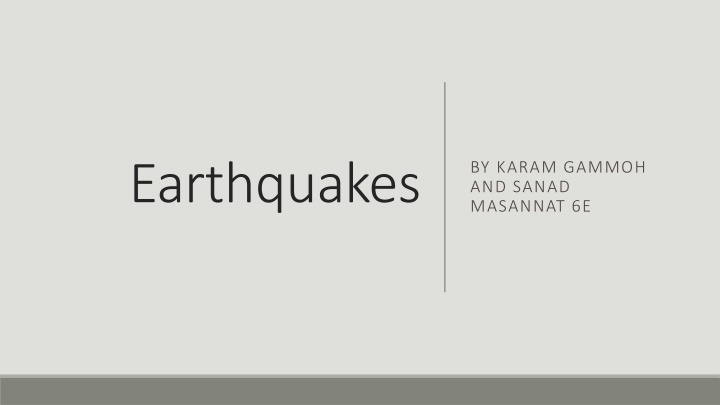
Earthquakes: Causes, Effects, and Safety Measures
Earthquakes result from tectonic plate movements, releasing built-up pressure and energy. They occur at fault lines, with the epicenter being the point of origin. Human activities can also trigger earthquakes. Mitigation strategies include building safer structures and earthquake preparedness. Seismometers are used for detection, and earthquakes are measured on the Richter Scale for intensity assessment.
Download Presentation

Please find below an Image/Link to download the presentation.
The content on the website is provided AS IS for your information and personal use only. It may not be sold, licensed, or shared on other websites without obtaining consent from the author. If you encounter any issues during the download, it is possible that the publisher has removed the file from their server.
You are allowed to download the files provided on this website for personal or commercial use, subject to the condition that they are used lawfully. All files are the property of their respective owners.
The content on the website is provided AS IS for your information and personal use only. It may not be sold, licensed, or shared on other websites without obtaining consent from the author.
E N D
Presentation Transcript
Earthquakes BY KARAM GAMMOH AND SANAD MASANNAT 6E
What are Earthquakes? Earthquakes occur along tectonic earth plate margins, also known as fault lines. When plates move past or towards each other the movement is not smooth because of friction between the plates. Friction causes the plates to get stuck and pressure to build up. Earthquakes occur when the plates move past each other suddenly releasing this build-up of pressure (and massive energy).
What are Earthquakes? The point where the earthquake starts is called the focus. The point at ground level directly above the focus is called the epicenter. The force of the earthquake (and destruction) is most severe at the epicenter and lessens gradually away from the center. Earthquakes happen in waves and are called seismic waves. The waves travel in circles away from the epicenter and can travel thousands of kilometers. Smaller earthquakes usually happen after the main one and are called after-shocks.
What are the causes of Earthquakes? Some earthquakes are caused by humans as they interfere with the water beneath the earth s surface Earthquakes happen because of the constant movement in tectonic plates of the earth s crust.
What protection measures can we take against earthquakes? We cannot prevent natural earthquakes from happening, but we can significantly mitigate their effects by identifying hazards, building safer structures, and providing education and training on earthquake safety. Some countries where they have a lot of earthquakes, like Japan, design and build their buildings on special foundations that have giant spring pads that allow the building to move with the earthquake to avoid its collapse.
What are some methods to predict and detect earthquakes? Seismometers allow us to detect and measure earthquakes by converting vibrations due to seismic waves into electrical signals, which we can then display as seismograms on a computer screen.
How are earthquakes measured? Earthquakes vary greatly in intensity. Some are very mild, and we do not even feel them, while others are extremely destructive. Scientists developed a scale for measuring earthquake intensity called the Richter Scale from 1 to 10. The Richter Scale is logarithmic, meaning that each number is 10x stronger than the number before. So, an earthquake of magnitude 7 is 10 times stronger than 6. And a quake of magnitude 8 is 10 times stronger than 7.
The impact earthquakes have on the environment Some environmental effects of earthquakes include: surface faulting, tsunamis, soil liquefactions, ground resonance, landslides and ground failure.
Thank you! Official Resources: https://www.usgs.gov/programs/earthquake-hazards/earthquake-magnitude-energy-release- and-shaking-intensity https://spaceplace.nasa.gov/earthquakes/en/ https://seismo.berkeley.edu/seismo.real.time.map.html https://scedc.caltech.edu/recent/Quakes/quakes0.html https://www.emsc-csem.org/Earthquake/world/
